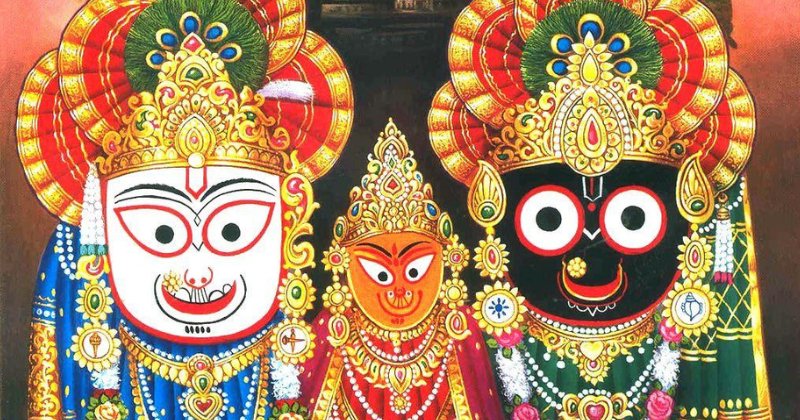The Jagannath Temple in Puri, Odisha, is not just a religious site—it’s a symbol of India’s rich spiritual heritage, mystery, and timeless devotion. For centuries, millions of devotees have flocked to this sacred place to seek blessings from Lord Jagannath, a form of Lord Vishnu and considered the Lord of the Universe.
But what makes Puri Jagannath so powerful, so mystical, and so unique among all temples in India? The answer lies in its incredible history, divine energy, and unexplained phenomena that science still can’t decode.

Who is Lord Jagannath?
Lord Jagannath is one of the most beloved and mysterious deities in Hinduism. His name means “Jagat ke Nath,” or the Lord of the Universe. He is believed to be a form of Lord Krishna, and is always worshipped with his elder brother Balabhadra and sister Subhadra.
Unlike traditional Hindu idols, the idol of Lord Jagannath is made of sacred neem wood, and has a flat face, large round eyes, and no hands or legs. This unique form is believed to represent infinity, incompleteness, and the truth that God is beyond shape or form.
The Story Behind the Jagannath Temple
The story of Puri’s Jagannath Temple begins with King Indradyumna, a devout ruler who dreamt of building a temple dedicated to Lord Vishnu. Guided by divine visions, he discovered a log of wood floating in the sea—known today as Daru Brahma, believed to carry the energy of the divine.
Lord Vishwakarma, the architect of the gods, agreed to carve the idols—but on one condition: no one should disturb him during the process. The king, impatient after weeks of silence, opened the doors early. The idols were half-finished, but a divine voice told him the work was perfect as it is. These unfinished idols became the sacred deities worshipped to this day.
Why Puri is One of the Char Dham?
Puri is part of the Char Dham—the four most sacred pilgrimage sites in Hinduism—along with Badrinath, Rameswaram, and Dwarka. It is said that no spiritual journey is complete without a visit to Jagannath Puri.
This temple represents the Eastern direction, and symbolizes moksha (liberation) through devotion. It is also the only place where the gods themselves come out of the temple to meet their devotees during the Rath Yatra.
The Rituals and Mystery of the Jagannath Temple
What makes this temple even more powerful is the list of unexplained phenomena that continue to baffle scientists and devotees alike:
- The flag atop the temple flies against the wind direction—every single day.
- The Sudarsan Chakra on top always faces you, no matter where you stand.
- The shadow of the main dome is never visible at any time of the day.
- The Mahaprasad cooked daily is never wasted or insufficient, even though it feeds thousands.
- Inside the sanctum, no sound of the ocean can be heard—even though it’s just nearby.
These signs, many believe, are proof of divine presence.
The Rath Yatra: Lord Jagannath’s Grand Journey
One of the most awaited festivals in India is the Jagannath Rath Yatra, celebrated every year in the month of Ashadha (June–July). On this day, the wooden idols of Lord Jagannath, Balabhadra, and Subhadra are placed on three huge, colorfully decorated chariots and pulled by lakhs of devotees.
The deities are taken to the Gundicha Temple, believed to be their aunt’s house. After nine days, they return to the main temple in a return journey called Bahuda Yatra. This beautiful tradition symbolizes that God doesn’t wait for you to come—He comes to you.
Want to know more about this year’s celebration? 👉 Read: Jagannath Rath Yatra 2025 – Full Coverage & Celebrations in Puri and Delhi
The Deity That Renews Itself: Nabakalebara
Another rare and fascinating ritual is Nabakalebara, which happens once every 12 to 19 years. During this event, the wooden idols are replaced with newly carved ones—but with a twist. The “life energy” or Brahma Padartha is secretly transferred from the old idols to the new ones in a sacred ritual performed in total darkness.
Only a few chosen priests know the secrets of this ritual. No outsider is allowed, and those who witness it are sworn to lifelong secrecy. This process reflects the belief that even God changes forms—but His soul remains eternal.
Conclusion: A Temple Beyond Time
The story of Jagannath Puri is not just about rituals and architecture. It is about faith that goes beyond logic, mysteries that science cannot explain, and a bond between God and devotee that feels deeply personal.
Whether you’re a pilgrim, a curious traveler, or a spiritual seeker, a visit to the Jagannath Temple is not just a religious trip—it’s a soul experience. The temple reminds us that God can exist in any form, and sometimes, it’s the incomplete forms that make us feel whole.
Read more about Jagannath Rath Yatra 2025 – Click Here